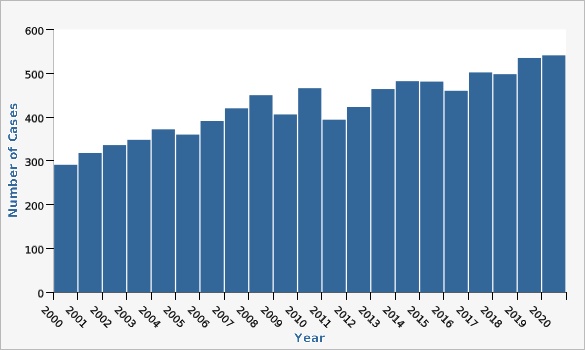Complete Health Indicator Report of Non-Hodgkin Lymphoma
Definition
The rate of non-Hodgkin lymphoma in Utah per 100,000 population.Numerator
The number of incidents of non-Hodgkin lymphoma among Utah population for a specific given time period (ICD-10: C82-C85).Denominator
Population of Utah for a specific period of time.Data Interpretation Issues
Cancer diagnoses in 2020 may be impacted by the COVID-19 pandemic due to the changes in health services and cancer screening accessibility.Why Is This Important?
Lymphoma is a type of cancer that begins in the cells of the lymph system. There are two main types of lymphoma, Hodgkin and non-Hodgkin lymphoma. There are many different types of non-Hodgkin lymphoma, which can be divided into aggressive (fast-growing) and indolent (slow-growing) types. Non-Hodgkin lymphoma can occur in different types of white blood cells (B-cells, T-cells, and NK cells), but the most common types form in B-cells [1]. Non-Hodgkin lymphomas can occur at any age and are often marked by enlarged lymph nodes, fever, night sweats, fatigue, and weight loss [2]. Some risk factors for developing non-Hodgkin lymphoma are older age, being male, and a weakened immune system. Prognosis depends on many factors, including the subtype of non-Hodgkin lymphoma, cancer stage, and the person's overall health.[[br]] [[br]] ---- 1 [https://seer.cancer.gov/statfacts/html/nhl.html][[br]] 2 [https://www.cancer.gov/types/lymphoma/patient/adult-nhl-treatment-pdq]What Is Being Done?
The Utah Leukemia and Lymphoma Society offers many services to those affected by these cancers such as educational information, support groups, advocacy and volunteer opportunities, treatment options, and research information. For more information visit [https://www.lls.org/utah].Related Indicators
Related Relevant Population Characteristics Indicators:
Graphical Data Views
Non-Hodgkin Lymphoma Number of Cases by Year, Utah, 2000-2020

| Year | Number of Cases | |||||
|---|---|---|---|---|---|---|
Record Count: 21 | ||||||
| 2000 | 291 | |||||
| 2001 | 318 | |||||
| 2002 | 336 | |||||
| 2003 | 348 | |||||
| 2004 | 372 | |||||
| 2005 | 360 | |||||
| 2006 | 391 | |||||
| 2007 | 420 | |||||
| 2008 | 450 | |||||
| 2009 | 406 | |||||
| 2010 | 466 | |||||
| 2011 | 394 | |||||
| 2012 | 423 | |||||
| 2013 | 464 | |||||
| 2014 | 482 | |||||
| 2015 | 481 | |||||
| 2016 | 460 | |||||
| 2017 | 502 | |||||
| 2018 | 498 | |||||
| 2019 | 535 | |||||
| 2020 | 541 | |||||
Data Source
Cancer data provided by the Utah Cancer Registry, supported by the National Cancer Institute (HHSN261201800016I), the U.S. Center for Disease Control and Prevention (NU58DP0063200), the University of Utah, and Huntsman Cancer FoundationReferences and Community Resources
[https://www.cancer.gov/types/lymphoma/patient/adult-nhl-treatment-pdq] [https://seer.cancer.gov/statfacts/html/nhl.html]More Resources and Links
Evidence-based community health improvement ideas and interventions may be found at the following sites:- Centers for Disease Control and Prevention (CDC) WONDER Database, a system for disseminating public health data and information.
- United States Census Bureau data dashboard.
- Utah healthy Places Index, evidence-based and peer-reviewed tool, supports efforts to prioritize equitable community investments, develop critical programs and policies across the state, and much more.
- County Health Rankings
- Kaiser Family Foundation's StateHealthFacts.org
- Medical literature can be queried at PubMed library.
Page Content Updated On 01/09/2024,
Published on 04/24/2024
